 W
WThe Order of Aftab (Nishan-i-Aftab) was founded by Nasser al-Din Shah Qajar, the King of Persia, in February 1873, before his first visit to various European states. The order came in two classes, the first class restricted to female sovereigns or consorts of reigning rulers and the second class to princesses and ladies of high rank, and those deserving of special recognition or signs of conspicuous appreciation by the Shah. In 1967 during the reign of the Pahlavi dynasty the statues of the order had changed, there changes included the name to the Order of Aryamehr, the insignia and the eligibility of receiving the order.
 W
WThe Order of Beneficence, is an order of Greece, that was established in 1948.
 W
WThe Cross of Merit for Women and Girls was created on 22 March 1871 by Kaiser Wilhelm I, German Emperor, in his capacity as King of Prussia. The award was presented only to women, but was not a Ladies Order in the most narrow sense. Women and girls were awarded at the request of Empress Augusta, and the award was bestowed by the Kaiser.
 W
WThe Imperial Order of the Crown of India is an order in the British honours system. The Order was established by Queen Victoria in 1878, when she became Empress of India and named after the Imperial Crown of India. The Order is open only to women and no additional appointments have been made since the Partition of India in 1947. The Order was limited to British princesses, wives or female relatives of Indian princes and the wife or female relatives of any person who held the office of:Viceroy of India, Governor of Madras, Governor of Bombay, Governor of Bengal, Commander-in-Chief India, Secretary of State for India, Governor-General of India.
 W
WThe Imperial Austrian Order of Elizabeth, founded in 1898 by Francis Joseph, Emperor of Austria and King of Hungary, was an order created for women. The order was the namesake of Saint Elisabeth of Hungary, but it was created to honor and memorialize Franz Joseph's late wife, Empress-Queen Elisabeth.
 W
WThe Order of the Ladies of the Cord, was a ladies order founded by the French queen Anne of Brittany in 1498. This rope with knots had been added by her step-grandfather Francis I, Duke of Brittany to his arms in honor of St. Francis its patron saint and her father Francis II, Duke of Brittany had continued the emblem. The order was founded after the death of her husband king Charles VIII. The choice of name is not clear. Some sources speak of the node in the Scourge of the Savior, others from the cord of the sacred Francis of Assisi and still others of deliverance from the pressing duty of the unfortunate and involuntary marriage of Charles and Anna.
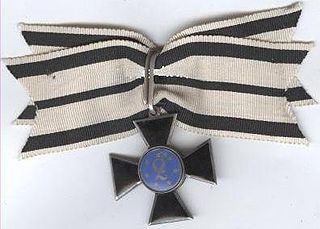 W
WThe Order of Louise was founded on 3 August 1814 by Frederick William III of Prussia to honor his late wife, the much beloved Queen Louise. This order was chivalric in nature, but was intended strictly for women whose service to Prussia was worthy of such high national recognition. Its dame companion members were limited to 100 in number, and were intended to be drawn from all classes.
 W
WThe Royal Order of Noble Ladies of Queen Maria Luisa is an Order created by King Charles IV of Spain by royal decree on April 21, 1792, at the request of his wife, Queen Maria Luisa, to reward noble women who distinguished themselves for their services and talents. As such, it was established as an honour reserved only for women.
 W
WThe Order of Olga (Württemberg) (German: Olga-Orden) was created by Karl I, King of Württemberg, on June 27, 1871, to honor his queen consort, Grand Duchess Olga Nikolaevna of Russia. Its primary purpose was to honor women who cared for wounded soldiers in the Franco-Prussian War of 1870 – 1871. While it was conferred on a few men, it remained largely a women's order.
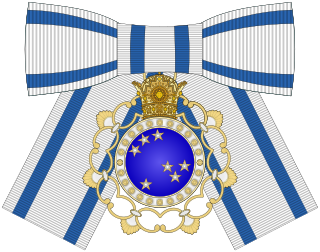 W
WThe Order of the Pleiades, also named Order of Haft Paykar, was an all-female order of the former Imperial State of Iran.
 W
WThe Order of the Precious Crown is a Japanese order, established on January 4, 1888 by Emperor Meiji of Japan, and the second lowest ranking of the Japanese orders currently awarded. Originally the order had five classes, but on April 13, 1896 the sixth, seventh and eighth classes were added.
 W
WThe Order of Saint Catherine was an award of Imperial Russia. Instituted on 24 November 1714 by Peter the Great on the occasion of his marriage to Catherine I of Russia. For the majority of the time of Imperial Russia, it was the only award for women; the Insignia of Saint Olga existed briefly from 1916 to 1917, but ceased with the fall of the Romanov dynasty.
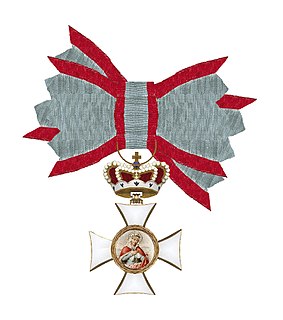 W
WThe Order of Saint Elizabeth was an all-female chivalric and charitable order in the Kingdom of Bavaria. The following excerpt is from The Orders of Knighthood, British and Foreign (1884): The first Consort of the Elector Charles Theodore of the Palatinate, Elizabeth Augusta, daughter of the Palatine Joseph Charles Emanuel of Schultzbach, founded this Order for ladies in honor of her sainted patroness and namesake on the 18th October 1766, as a purely charitable institution for the poor. It was confirmed on the 31st of January 1767, by Pope Clement XII, and endowed with various indulgencies. The Catholic religion and the Seize Quartiers – the proof of noble descent running through sixteen generations of their own or their husband’s ancestors – are indispensable conditions for candidates. The Grand Mistress is, however, empowered to nominate and unlimited number of ladies, from Princely Houses and her own Court, as also six other married or widowed ladies of noble, but not ancient descent. The nomination takes place either on Easter or on Saint Elizabeth’s Day. The entrance fee is four ducats. The badge is a white enameled cross, representing on one side Saint Elizabeth dispensing charity to the poor, and on the other, the initials of the founder. It is worn on the left breast by a blue ribbon with a red border. No Member can appear in public without it, except by fine of one ducat. The King appoints the Grand Mistress.
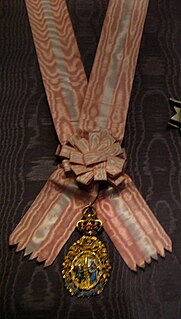 W
WThe Order of Queen Saint Isabel is a Roman Catholic dynastic order of which the Grand Mistress is the Duchess of Braganza.
 W
WThe Royal Family Order of Saints Olga and Sophia was an order of the Greek royal family. Reserved for women, it was the third highest honour of the modern Greek state and the Crown after the Order of the Redeemer and the male-only Order of Saints George and Constantine. It was instituted in January 1936, by King George II in the memory of his grandmother and his mother.
 W
WThe Order of Sidonia was the German Kingdom of Saxony’s chivalric order for women. Created March 14, 1871 by King John, the order was granted to female members of the Saxon nobility until the fall of the monarchy in 1918. It was named for the duchess of Saxony, Sidonia of Bohemia.
 W
WThe Order of the Starry Cross is an imperial Austrian dynastic order for Catholic noble ladies, founded in 1668. The order still exists under the House of Habsburg, though the Austrian Empire no longer exists.
 W
WThe Tallinn Museum of Orders of Knighthood is a private museum of history and culture in Tallinn, Estonia. The main focus of the museum is the history of orders of knighthood and merit from all over the world. The museum is located in a historical medieval building at Kuninga 3 in Tallinn Old Town, and the permanent exhibition consists of close to a thousand original costumes, collars, stars, badges and other items related to orders of knighthood with the oldest exhibits dating to the beginning of the 18th century.
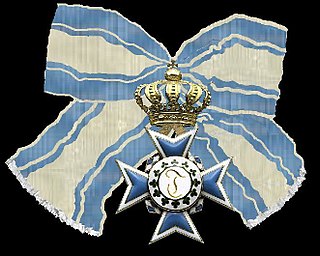 W
WThe Order of Theresa was an order for noble ladies in the Kingdom of Bavaria. It continues to function today as an honorary society to which belong the princesses of the House of Wittelsbach as well as other ladies from Bavarian noble families.